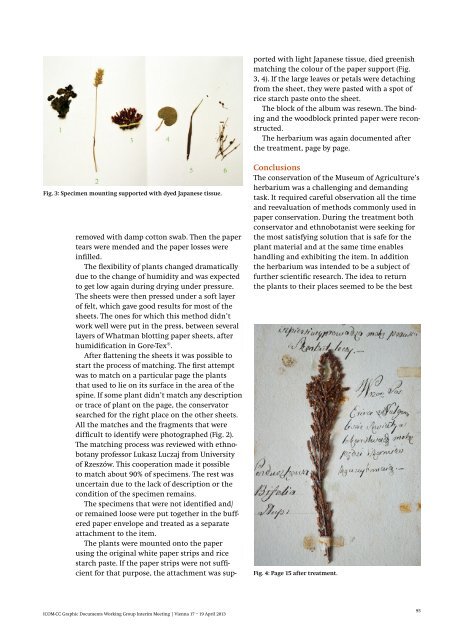Paper Conservation: Decisions & Compromises
Paper Conservation: Decisions & Compromises
Paper Conservation: Decisions & Compromises
Create successful ePaper yourself
Turn your PDF publications into a flip-book with our unique Google optimized e-Paper software.
emoved with damp cotton swab. Then the paper<br />
tears were mended and the paper losses were<br />
infilled.<br />
The flexibility of plants changed dramatically<br />
due to the change of humidity and was expected<br />
to get low again during drying under pressure.<br />
The sheets were then pressed under a soft layer<br />
of felt, which gave good results for most of the<br />
sheets. The ones for which this method didn’t<br />
work well were put in the press, between several<br />
layers of Whatman blotting paper sheets, after<br />
humidification in Gore-Tex®.<br />
After flattening the sheets it was possible to<br />
start the process of matching. The first attempt<br />
was to match on a particular page the plants<br />
that used to lie on its surface in the area of the<br />
spine. If some plant didn’t match any description<br />
or trace of plant on the page, the conservator<br />
searched for the right place on the other sheets.<br />
All the matches and the fragments that were<br />
difficult to identify were photographed (Fig. 2).<br />
The matching process was reviewed with ethnobotany<br />
professor Lukasz Luczaj from University<br />
of Rzeszów. This cooperation made it possible<br />
to match about 90% of specimens. The rest was<br />
uncertain due to the lack of description or the<br />
condition of the specimen remains.<br />
The specimens that were not identified and/<br />
or remained loose were put together in the buffered<br />
paper envelope and treated as a separate<br />
attachment to the item.<br />
The plants were mounted onto the paper<br />
using the original white paper strips and rice<br />
starch paste. If the paper strips were not sufficient<br />
for that purpose, the attachment was supported<br />
with light Japanese tissue, died greenish<br />
matching the colour of the paper support (Fig.<br />
3, 4). If the large leaves or petals were detaching<br />
from the sheet, they were pasted with a spot of<br />
rice starch paste onto the sheet.<br />
The block of the album was resewn. The binding<br />
and the woodblock printed paper were reconstructed.<br />
The herbarium was again documented after<br />
the treatment, page by page.<br />
Fig. 3: Specimen mounting supported with dyed Japanese tissue.<br />
Conclusions<br />
The conservation of the Museum of Agriculture’s<br />
herbarium was a challenging and demanding<br />
task. It required careful observation all the time<br />
and reevaluation of methods commonly used in<br />
paper conservation. During the treatment both<br />
conservator and ethnobotanist were seeking for<br />
the most satisfying solution that is safe for the<br />
plant material and at the same time enables<br />
handling and exhibiting the item. In addition<br />
the herbarium was intended to be a subject of<br />
further scientific research. The idea to return<br />
the plants to their places seemed to be the best<br />
Fig. 4: Page 15 after treatment.<br />
ICOM-CC Graphic Documents Working Group Interim Meeting | Vienna 17 – 19 April 2013<br />
95
















